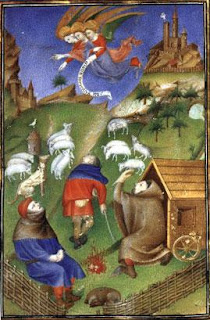Friday, September 30, 2011
Question for October 3: Doctor Faustus (pp. 1041-55)
Throughout the play, Doctor Faustus has chances to repent and renounce Lucifer. Why doesn't he repent?
Wednesday, September 28, 2011
Question for September 30: Doctor Faustus (pp. 1022-41)
In Christopher Marlowe's play, "The Tragical History of Doctor Faustus," the title character sells his soul to Lucifer in exchange for twenty-four years of otherworldly power. What seems to be the motive of Faustus? He wants power, certainly, but on the surface of it, this seems like an extremely shortsighted bargain. What is your informed hypothesis, based on your reading of the play so far?
Monday, September 26, 2011
Question for September 28: Sidney (8:00 class)
Sir Phillip Sidney has been called "the logician in love"--meaning that his sonnets about Stella show his interest in logical thinking rather than great passion. Based on your reading of sonnets 1, 20, 47 and 91 (pages 975-76, 979, 983, and 989-90), what do you think? Are you convinced that Sidney is in love, or is he merely trying to impress his readers? Use examples from the sonnets to back up your answer.
Monday, September 19, 2011
Question for September 21: The Second Shepherds' Play (8:00)
The Second Shepherds' Play is the first work we've seen containing both a plot and a comic subplot. The story of the shepherds, Mak and Gill are a comic parallel to an important event in Christianity. Discuss the parallels between the plot and sub-plot. (To get you started, both plots contain a mother figure.)
Friday, September 16, 2011
Question for September 19: The Pardoner's Tale (8:00 Class)
What we know about the Pardoner's motives for preaching may affect our response to his Tale. Does the tale effectively tell a story with a good moral? How does the tale reflect the Pardoner's character?
Wednesday, September 14, 2011
Question for September 16: The Prologue to the Pardoner's Tale (8:00 Class)
Both the Wife of Bath and the Pardoner reveal a great deal about themselves and their ethical standards in the prologues to their tales. Briefly compare the shortcomings of the two. (The Wife of Bath's Prologue is on pages 257-275. The Pardoner's Prologue, our reading for today, is on pages 284-88.) Which of the two characters does Chaucer portray less favorably than the other? Defend your answer with at least one reference to the text.
Saturday, September 10, 2011
Question for September 14: The Wife of Bath's Tale
Comment upon the ways in which the Tale of the Wife of Bath (pages 275-84) is a reflection of her own view of the world. (You might look at theme, characters, or plot, or consider how this tale could only be told by the Wife, not by any of the other pilgrims to whom we've been introduced.)
Question for September 12: The Prologue to the Wife of Bath's Tale (8:00 Class)
Chaucer's narrator briefly describes the Wife of Bath in the General Prologue to The Canterbury Tales. In the Prologue to the Wife of Bath's own tale (pages 257-74), he lets her tell her own story. Today's question is this: In her Prologue, does Chaucer reveal a fictional character that readers are meant to laugh at, or to admire? Or is she a mixture--a comic character with some admirable qualities? (Remember the rules for posting: For full credit, your comment must be 250-300 words long and must be posted before our class on September 12. In addition, you must include at least one substantial quotation from the text to back up your answer, and unless you are the first person to post you must refer to the comment of another classmate. (Saying, "As so and so said, . . ." is not really a reference. Enlarge upon another comment, or disagree with it, and tell why.)
Saturday, September 3, 2011
Question for September 9: The Prologue to The Canterbury Tales, pp. 229-38
The Summoner and the Pardoner are both church officials. Choose one of the two and discuss how Chaucer's description of him hints at his disapproval of how he carries out his job.
Question for September 7: The Prologue to The Canterbury Tales, pp. 218-29
In lines 43-446 of the Prologue to The Canterbury Tales, we are introduced to more than a dozen 14th century characters. Chaucer is noted for using details to make his characters realistic and lifelike.
Choose one character (Knight, Squire, Yeoman, Prioress, etc.) and discuss how the details Chaucer chooses make the character into an individual. How do Chaucer's descriptions make a social commentary on roles in Medieval life?
Choose one character (Knight, Squire, Yeoman, Prioress, etc.) and discuss how the details Chaucer chooses make the character into an individual. How do Chaucer's descriptions make a social commentary on roles in Medieval life?
Subscribe to:
Comments (Atom)

